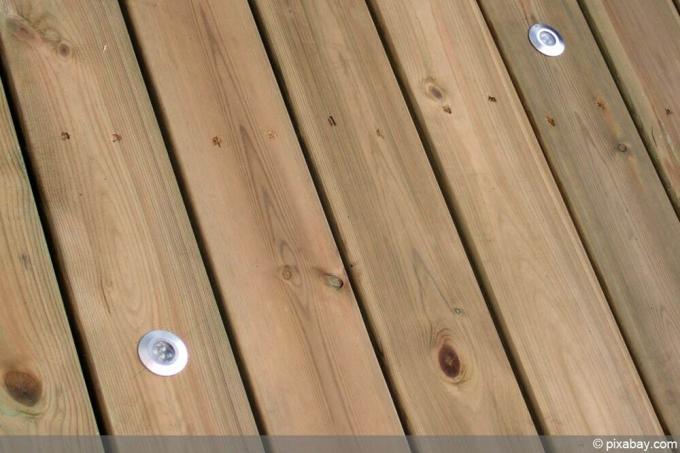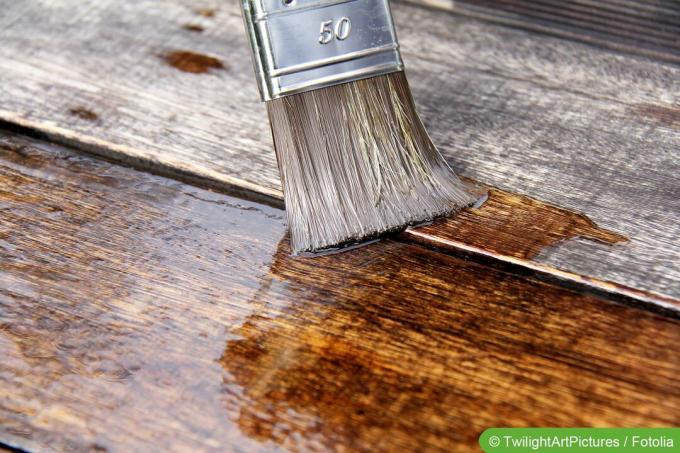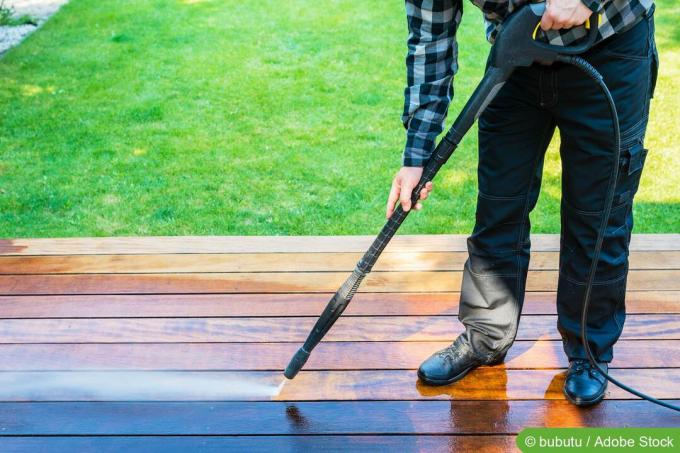

Table of contents
- selection criteria
- Tropical decking wood
- Domestic terrace wood
- WPC boards for the terrace
- Comparison of wood types
Tropical types of wood are extremely popular as patio wood. Because they are very hard and have a high resistance to wood-destroying fungi. But is it really necessary to use patio wood from the other side of the world, or can local wood also score points? Our comparison shows the advantages and disadvantages of the types of wood and reveals what needs to be considered when choosing the decking wood.
selection criteria
Of course, it is tempting to choose the decking wood solely based on its appearance or the purchase price. After all, many already have an exact picture of the new veranda in front of their inner eye and also a fixed budget.
Before buying, however, other factors should also be considered so that there are no nasty surprises in terms of processing, care and durability. These key points include:
- abrasion resistance
- durability
- hardness
- Costs
- optics
- ease of care
- weather resistance
In addition, four quality characteristics should be considered when selecting and comparing the type of wood. These are:
- Durability: Wood-destroying fungi can cause a lot of damage. The decking wood should therefore have resistance class 1 or 2.
- Origin: The indication FSC-100% stands for safe origin and sustainable cultivation
- wood quality: FAS is an abbreviation for "First and Seconds", i.e. wood of first and second choice and thus for the highest quality. In Germany, the term Premium is also widespread.
- Drying: Drying the wood prevents the planks from warping and bending later. Woods that have been technically dried or are marked KD (kiln dried – dried in a drying chamber) are ideal.
Tropical decking wood

Tropical woods are very popular. Due to their origin, they are highly resistant to wood-destroying fungi and insect infestation, and for this reason, among other things, they are very durable. In addition, they are weatherproof and abrasion-resistant. No wonder, then, that the following types of tropical wood are often used in terrace construction:
- Bangkirai
- Bilinga
- Cumaru
- Garapa
- Ipe
- Keruing
- Massaranduba
- teak
However, these types of wood do not only have advantages. Since tropical types of wood are very hard, they are also difficult to work with. This sometimes requires special, hardened tools. In addition, a lot of time, effort and energy. Even then, it is not always possible for non-professionals to cleanly process the decking. Bleeding also needs to be considered. This leads to unsightly, dark discolorations - which can also result from contact with iron.
In addition, tropical wood has to travel long distances. As a result, the transport is not exactly environmentally friendly. Not to mention the deforestation, which severely interferes with the habitat of animal species, some of which are threatened with extinction. If it is nevertheless to be tropical wood for the terrace, the origin should therefore be checked. The FSC-100% seal ensures that the wood comes from a sustainable and socially responsible economy.
In comparison, tropical types of wood are expensive to buy. However, with appropriate care, it is also very durable. It is therefore necessary to weigh up whether the costs for acquisition and professional processing should be borne or whether the veranda should be renewed more frequently.
Domestic terrace wood
Terrace wood from local forestry is usually significantly cheaper than tropical wood. On the one hand, this is due to the shorter and therefore more environmentally friendly transport routes. However, also in that they have a significantly lower hardness and durability. The Douglas fir, for example, has only half the service life of tropical types of wood. This is neither an estimate nor an advantage, the shorter service life is actually documented by DIN standards.
Nevertheless, native wood species also have advantages to offer. The following are suitable for terrace construction:
- douglas fir
- Oak wood
- larch
- Black Locust
- thermo ash

These do not bleed out, but give off the highest resin. With high-quality and appropriately processed variants, however, even that is not a problem. In addition, they are significantly cheaper. Even the lower hardness does not have to be a pure disadvantage. Because it means that the wood is easier to work with. Especially if you want to build the terrace yourself, it is better to use local wood. In addition, in many cases it is not necessary for the terrace wood to be as hard as the types from the tropics. With normal use and a location that is not consistently damp, cool and dark, domestic woods can easily keep up.
WPC boards for the terrace
The WPC floorboards are a combination of wood and plastic, which combines the advantages of both materials. They are made from wood flour and special so-called polymers. The proportion of wood is usually between 30 and 50 percent. The higher the proportion of wood, the more natural the floorboards appear. However, the wood content says little about the durability.
Therefore, the decision can be made here in favor of cheaper types of wood or variants with a lower natural content. The advantage is that WPC planks are more resistant to moisture, fungi and insects. The price is a bit higher due to the production process - however, the planks are still cheaper than treated domestic wood and tropical wood.
Comparison of wood types
For the individual comparison, the most important types of wood for terrace construction together with their properties, advantages and disadvantages have been compiled here.
Bangkirai
Bangkirai - also spelled Bankirai - is very tough and resilient and was trending for a while. Unfortunately, that turned out to be a disadvantage. The great demand ensured that the wood was partly sold without drying and storage. The result was bent and warped floorboards and massive deforestation of the corresponding forests. This problem can be avoided by taking origin and drying into account. However, the Bangkirai is still problematic:
- Discolouration from brown to gray to black from light, time and exposure to ferrous metals
- holes by insects
- Hardly any uniform quality, since different woods belong to the Bangkirai group
- Hardly any grain, therefore optically not very attractive
Bilinga
Resilient, resistant to fungi and insects - Bilinga is not exactly cheap, but it is durable and easy to care for. However, over time it becomes dark and gradually grays. Even regular treatment with decking oil can only delay this development but not prevent it completely. In addition, a constructive wood protection should be applied.

Cumaru
Cumaru is also known as Brazilian teak but is rarely found in Europe. However, it is beginning to gain acceptance because it has the highest resilience outdoors and is particularly hard. Care is only required - and possible - in the form of decking oil. Because the Cumaru wood hardly accepts other substances.
Two clear disadvantages, however, are that building the terrace yourself is difficult or impossible. The wood is so hard that it is difficult to work with. In order not to cause any damage, professionals should therefore take over the assembly. In addition, cumaru from sustainable cultivation is only available in very small quantities in Europe and is therefore correspondingly expensive.
Garapa
Garapa is sluggish - so it takes a long time to dry, but is also well suited to damp areas, hardly bending or warping. Machining is still relatively easy with the appropriate carbide tools. For clean results, however, professional processing and assembly should also be carried out here.
Ipe
Ipé is rather unknown in this country but very high quality. Ipé wood is characterized above all by its resistance to insects. However, this also makes it very expensive.
douglas fir

Douglas fir is inexpensive and easy to work with. It is therefore ideal for building your own terrace. However, the domestic wood is not particularly durable and, as mentioned, has a service life of just half that of tropical wood. It dries quickly, but should be stored for a long time to prevent resin leakage.
The partly golden-brown coloring and appealing grain are visually appealing. The low price, on the other hand, is convincing.
Black Locust

thermo ash
Hard, resilient, resilient and durable - the thermal ash is also a wonderful alternative to tropical types of wood for the terrace. The wood has to be treated in a special way and is therefore usually a bit more expensive - but the investment makes ecological sense and pays off in the long term.
Image source: HDH (Main Association of the German Timber Industry)
 Home editorial office
Home editorial office
Learn more about decking wood

Maintaining and cleaning teak
Teak is a particularly noble and durable wood that is also often used outdoors. When it comes to proper care and cleaning, however, there are a few points to keep in mind. We show what is important to ensure that the teak furniture remains attractive for a long time.

Douglas fir wood for the terrace - prices, durability and care
The Douglas fir is one of the native types of wood and has a nice, warm and somewhat reddish hue that is similar to larch wood. It is quite weather resistant and can therefore also be used for garden furniture and patio floors.

Exclusive natural pool: how much does a swimming pond cost?
Swimming ponds are becoming increasingly popular with many homeowners as an alternative to the classic swimming pool. An exclusive natural pool combines the properties of a swimming pond with the amenities of a pool. The customization options for an exclusive swimming pond depend on individual taste.

Wooden terrace - which wood, which glaze to use
If you want to enjoy your wooden terrace for a long time, choosing the right wood and caring for it is essential.

Cleaning a wooden terrace – which wood is easy to care for?
Once again, cleaning the decking is on the to-do list. Oak, Douglas fir, teak, larch or Bangkirai - different types of wood require different care and cleaning methods.

Wooden terrace - which popular types of wood to choose?
For many, the terrace offers additional living space in the warm season, which people like to use for a cozy get-together. If you are considering covering the floor with a wooden covering, you will find a difficult to oversee range of garden wood and corresponding kits in the DIY and specialist stores.
